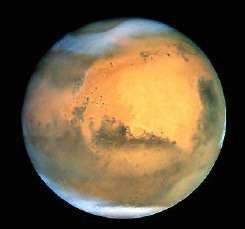Mineral discovery explains Mars' landscape

A Queen's University researcher has discovered a mineral that could explain the mountainous landscape of Mars, and have implications for NASA's next mission to the planet.
"Satellites orbiting Mars show us images of canyons and gullies that appear to have been created by a flood or rapid out-washing," says Ron Peterson, Queen's geologist. "These rovers, currently moving about on the planet's surface also show us that there is currently no visible water on the surface of Mars, but that there was in the past."
Dr. Peterson suggests that Mars was likely wetter in the past. All of the images that are coming back from the rovers show layering in the rock which is indicative of sediment manipulated by water. This kind of out-wash would require a fair amount of water on the planet at some point.
The study, published this week in the Geology, a publication of the Geological Society of America, suggests that these findings may provide insight into how to retrieve a sample of Mars surface and return it to earth.
Dr. Peterson will share his findings with NASA at the Johnson Space Centre in Houston next week to provide insight into designing the next Mars exploration rover and planning its mission.
The discovery was made in Dr. Peterson's unheated garage using epsomite, also known as Epsom salts. The solution was left to crystallize for several days at temperatures below freezing, which formed crystals that have unusual properties. The crystals then rapidly melted, which created mould-like channels and gullies – similar to what we see on the surface of Mars.
Martian terrain may have been created in a similar fashion. Dr. Peterson suggests that many years ago, water interacted with rocks on the surface of the planet to create an acidic cocktail, which created layers of material. When the surface layer melted, it created the topography that exploration rovers show us today.
"These findings may help us better understand the surface of Mars," says Dr. Peterson, expert in geological science and engineering. "These possible new minerals that may be found on Earth help us see that although there are many differences between Earth and Mars, such as atmosphere and gravity, there are many things that are the same – it is another world, but there are certainly similarities."
Source: Queen's University



















